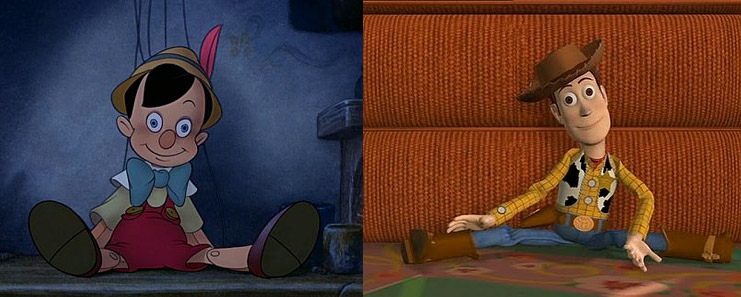They didn’t think it was relevant. In their minds, we were working on computer-generated images—and for them, what was a computer-generated image? What was an image they saw on a CRT? It was television.Ed Catmull, co-founder of Pixar and pioneer of computer graphics, on the time he and his nascent team were brought in to ILM during the filming of the second Star Wars movie.
From an ACM Queue interview between Catmull and Pat Hanrahan. There are also some good quotes about incubator projects like ARPA providing protection for new ideas, arts education, and the role of artist-scientists in the graphics field.
Tag: pixar
-
Catmull Interview
-
Woody Pinocchio

From Bat, Bean, Beam’s essay The Unmaking of Pinocchio on the difficulties Disney and Pixar both faced, decades apart, in creating lovable puppets, contrasted with the original source material from Carlo Collodi’s dark fairly tale of self agency and society:
When John Lasseter and his colleagues at Pixar set about making their first animated feature, they struck the exact same trouble that had beleaguered old Walt: two years into production, whilst presenting an early draft to Disney’s producers, they came to the realisation that their central character, Woody the Sheriff, was a sarcastic and unlovable brat. ‘A thundering arsehole’ were co-screenwriter Joss Whedon’s actual words. And so again the work of animation was halted, the production team regrouped and a major rewrite ensued, to ensure that Woody would be warmed to and therefore that the film could succeed. And in this case too I have little doubt that it was the smart thing to do; besides, there was no fidelity to be compromised in the process, no book to betray, unless one were somehow inclined to regard Pinocchio as an implicit ur-source, the ghost of puppets past haunting Woody from beyond the grave.
-
Objects of Play
From an insightful entry on the Toy Story trilogy on Bat, Bean, Beam:
Of course the toys aren’t really toys, they are allegorical figurines that we are supposed to read human meanings into, but I want to try to be literal for a moment. There is one irrefutable truth that we learn through the films about the toys’ psychology, one trait that all of them except a pair of scarred deviants – Stinky Pete and Lotso – have in common: what they like best is to be played with by children. But it so happens that at those times they are limp and inanimate; as is the case whenever they are in the presence of people, their spark abandons them, their eyes become vacant – a point that is further underscored in Toy Story 3 by the otherwise extraordinary capacity for expression of those eyes. So what the toys derive the most pleasure from is also what flicks their off switch, reverting them to the base status of mass produced consumer objects: every Sheriff Woody, every Buzz Lightyear totally identical to any other, therefore totally interchangeable, Andy’s marker-pen branding notwithstanding.
That is curious, from a philosophical point of view. More unhappy/unheimlich psychoanalysis of the Toy Story fiction over at Frieze Magazine.
-
It Is the Thought and Circumstances Behind the
It is the thought and circumstances behind the action that will make the action interesting.
Advice from Ollie Johnston, one of Disney’s “Nine Old Men”. Excerpted from a longer list of more animation-specific advice, I think this one stands nicely on its own.
(Via Drawn)
-
Salon: The Aesthetic Gulf Between Miyazaki and Pixar
In place of the conventional, reductive versions of morality and psychology shown in Pixar’s films, Miyazaki gives us something closer to actual experience, treating good and evil not as a binary equation but as a sliding scale and presenting people (and characters) that often don’t know why they do what they do and latch on to reductive explanations at their peril. Characters can be scary and then friendly, threatening and then reassuring, honest and then misleading; they can shift identities and change shape, succumb to spells and then break out of them. […]
Parents will testify that a child who sees his or her first Miyazaki film after a steady diet of Pixar and Disney is apt to experience a perhaps troubled reaction, much deeper than “That was fun” or “I liked it.” Miyazaki challenges every preconceived notion about family entertainment that Pixar and its ilk conditions children (and adults) to have. Pixar’s very best work this decade — “The Incredibles,” “Wall-E” and “Up,” and moments of “Monsters, Inc.” and “Finding Nemo” — is wonderful; it gives children lots to see and a fair amount to feel. But Miyazaki’s work does more than that. His art is engrossing and beautiful but also challenging. He urges children to understand themselves and the world, and then shows them how. The Babysitter mesmerizes children. Grandfather changes their lives.
From Salon’s “Directors of the Decade” countdown (Pixar and Miyazaki share the #2 slot). I think it’s a bit reductive to count “Pixar” as a director (why not specifically highlight Brad Bird or Andrew Stanton’s work?), but I know what they’re getting at. Pixar represents the best storytelling in American animation and both approaches have their valid points, but it’s interesting how much stronger of a moral stamp Miyazaki has on Studio Ghibli’s output.
(Via Mayerson on Animation)
-
Animatronic Luxo Jr.
An animatronic version of Pixar’s Luxo Jr. has appeared outside Disney’s studios in Hollywood, performing a couple of different shows depending on the time of day. That’s some fluid movement there! Even in robotic form, the character exudes more pathos than most animated film characters do in their respective movies. (Via Boing Boing Gadgets, which has the other Luxo performance video handy for watching)
